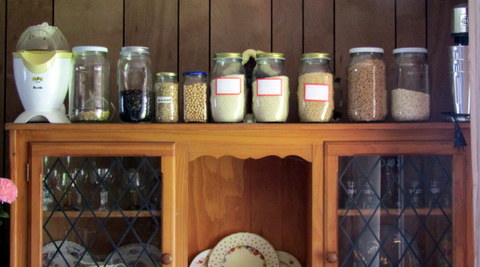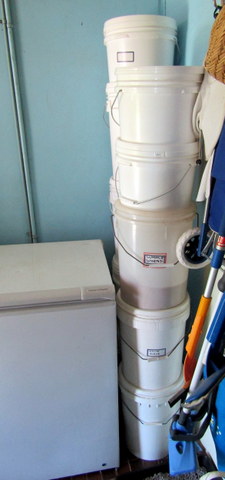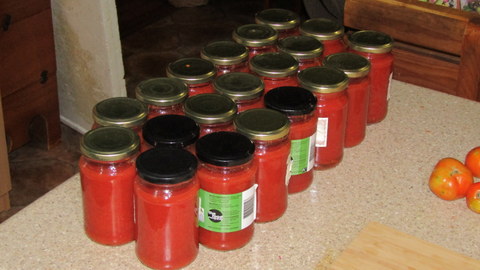Back in the 80’s when I started out on this journey it was called survivalism and these days it is talked about in terms of ‘prepping’, but both philosophies can have negative connotations and tend to focus on the individual and depending on where you are in the world, can also focus on guns and ammo! I prefer the term resilience, which can be an individual but also a community aspiration.
It does make sense to have some form of back-up food supply in an uncertain world, not only for you and your family but also so you can help those less fortunate in times of need.
There are also other advantages to having some food storage over and above your immediate needs as well as increasing your resilience –
- More flexibility of meal planning at short notice,
- The ability to throw a meal together in the event of unexpected guests without needing a run to the shops
- Reduced likelihood of running out of a critical ingredient while cooking, requiring another run to the shops.
- Where the food item are bought in a supermarket, if you keep some stock you can wait until that item is available at reduced price/on special, thus saving you money.
- If you are buying bulk amounts of ingredients this will also save you money as well as reducing the amount of packaging you generate.
Plus if there is a situation where supplies are getting low, you won’t be competing for the stuff left in the shops; that can go to the people who really need it as you will already have yours.
The downside of setting up food storage is that it is quite possible to buy in too much, or too much of the wrong stuff, resulting in the food going off or otherwise taking up space and not being eaten, with the associated wastage of both food and money. I have made these type of mistakes in the past much to my disappointment with myself, but what we do these days works very well (for us at least) so I will describe it for you.
Research
We found that if we wanted to start a meaningful storage program, we first needed to understand what food items we already had floating around home, so we did a pantry audit and included the fridge. This gave us a feeling for what we already and on hand and how much, so that we could avoid buying too much of stuff we already had, what it didn’t do was give us a feeling for how much stuff we bought in, and from where. So to do this I constructed an excel spreadsheet to keep track of this information (see here, about half way down) and filled it out for some months. By knowing how much of what we were buying it was easier for decisions to be made about how much of what to store, what could be improved by bulk buying and what opportunities there might be to home-make stuff for ourselves.
Bulk Staples
We buy most of the staples which we eat on a regular basis in bulk by the bag (12.5 kg, 20kg or 25kg depending on the material), and then store them in 20 litre polypropylene sealable buckets, most of which are kept in the laundry. Such staples include –
- Rolled oats – organic – used mainly for my muesli but can be used to make Linda’s porridge or oat milk, which is not as disgusting as it sounds! They are great for Anzac biscuits or to make a pie crust and to grind and add to bread to for a nutty flavour. We buy them 25 kg at a time from an organic foods bulk supply. Due to issues with pantry moth, we keep the bulk bag in the freezer and pack off a 10 litre bucket for day to day use as required.
- White Rice – Before you email me, I know how brown rice is sooooo much better for us, but white rice lasts longer in storage, and besides, we prefer white rice. It provides a great source of carbs whether it is boiled, steamed or fried and it can be ground to flour and used to make rice noodles or spring roll wrappers or even gluten free pasta (if that is your thing) or fermented to make a spirit or vinegar. We buy Australian long grain rice (because that is what we like) from a local Asian food supplier.
- Whole wheat – organic – we have been using it, bought direct from the mill, by the 20kg bag (originally in 12.5 kg bags) for years so about 8 years ago we bought a quite professional electric grain mill from Skippy grain mills and mill the whole grain to flour as we use it, for raised bread, flatbreads, pizza dough etc. Whole wheat flour can go stale comparatively quickly but as the whole grain it stores for years.
- Powdered Milk – We started out using the 1kg bags from woollies and got used to the taste, but we bought a 25kg bag of non-instant Australian produce skim milk and found it actually to be much more palatable than the woollies stuff. It works out to 60c per litre of milk. As well as being used as milk once reconstituted it can be used to make yoghurt or low fat cheese quite easily. We buy it from a food industry supply place in towards the city.
- Baker’s flour – we found years ago that whole wheat products can tend to be a bit heavy so we bake our breads etc. as a 50:50 mix of whole wheat and baker’s flour. We get organic unbleached bakers flour by the 12.5 kg bag from the organic bulk food supply.
- Sugar – white sugar, not much to say, we tend to buy a stack of 3kg paper bags of white sugar from woollies and repack into the 20kg bucket and recycle the paper bags.
Semi – Bulk staples
These are products which we keep a ready supply of, but don’t go through them quickly enough to make it worth buying in huge amounts. They are quite often bought packaging-free into our own glass jars from an organic bulk supply shop. This includes products such as
- lower use flours like white self-raising and plain flour and cornflour
- alternative rices such as basmati and Jasmin rice (yes, even a bit of brown!)
- Other muesli components such as raisins, sultanas and wheat bran straws
- Lower use sugars like brown sugar and icing sugar
- Dried legumes such as red kidney beans, black turtle beans and chickpeas
- Nuts like almonds, cashews and walnuts which can be eaten as is or put into cooked dishes
Canned Goods
Canned fruit, vegetable and meat were the backbone of our original storage program, and for most of them I committed the ultimate sin of storing them without integrating them into our meal plans, violating the cardinal rule of ‘store what you eat and eat what you store’. There were a number of reasons for this but in the end it meant that some stuff was in storage for 20+ years and wound up being composted/recycled instead of eaten.
We still do store some canned goods but in a severely reduced numbers and variety. These days the cans we store in any amount are limited to corn kernels, peaches in juice and beetroot. We use them on a regular basis (as was pointed out when I analysed our shopping habits) so we keep enough to last between the times when they are on special. How often they are used and the size of the can will dictate how many cans we store such that we will have up to half a dozen 825g beetroot tins but a couple of dozen 400g corn tins. This is still considerably less than the boxes of cans we stored previously. This also does not take into account the odd cans of fish, pineapple, pie apple or whatever that are likely to appear in anyone’s pantry, depending on their tastes.
Home Preserves
Over the years we have tried quite a few methods of preserving bought in excess or excess stuff we grew ourselves including drying, freezing, bottling and pickling. The way we grow our food these days means that we get a steady if small supply rather than the seasonal gluts we used to, so the need to preserve excess produce is reduced. There is one main exception to this – tomatoes!
Around the end of the year we mix our own tomato produce with bought in stocks (organic when we can afford it, but local at least and preferably chemical free) and turn some into pasta sauce/passata, some into diced tomatoes and some into pizza sauce. We usually process enough in a couple of weekends to last us for the coming year.
We also do a bit of drying, mostly leaf crops, but I am interested in growing or buying mushrooms and then drying them for later rehydration and to be turned into powder as a flavouring agent.
Sundries
These are the little bits that add flavour like spreads, sauces and spices. For the most part we will keep one or two spares of the usual size container we buy so that we don’t run out at a critical time and have to go bolting for the shops! The exception is spice mixes. Rather buy in jars of spice mixes like curry powder, Mexican spice or stock powder, we keep stocks of whole spices which we then grind and blend ourselves. It is not as difficult as you might think and there are some recipes elsewhere on this site, but we have found that having a copy of Hemphill’s ‘Spice and Herb Bible’ invaluable in making our own spice mixes.
Practice
No I don’t mean screaming “We’re all gonna die!” and running for the bunker. Life is busy and you might not get to practice your skills every day, so some programmed practice time is a good thing. Get the family involved and make it a fun challenge!
Every year we do ‘No Buy July’ and this gives an opportunity to test our skills and preparations which we hope will make us more resilient. You can read the detail here, but essentially we commit to buying almost nothing for a month, just subsisting on our stores and what we grow, using the skills we have learned in cooking, food processing and using what we have. If we are short of something, or have run out, how can we make use of what we have to get where we want to go?
Running ‘No Buy July’ gave us the motivation to make use of the skills, ideas and preparations we had made to improve the resilience of our lifestyle to see how well they worked. It was fun and most educative to see what worked, what didn’t, where we were successful and where more thought, training or practice was required. At the end of No Buy July (it could be any month or any time for you) we look at how things went. What the learnings were and how we would improve for next year.
Conclusion
The approach we use is not a knee jerk, ‘go out and buy a warehouse full of toilet paper corona is upon us’ type of approach. It is a measured approach taking time to design things so that waste is minimised. It worked well for us and made sure we were storing the right stuff, the right way, for us, and that we were able to use it when needed. Everyone’s tastes are different so if you want to put together some food storage, for any of the reasons outlined above, you need it to fit your families’ needs, and to work for you. So give our process a go and see how it works for you.






